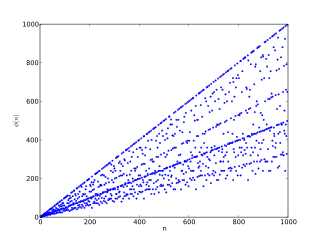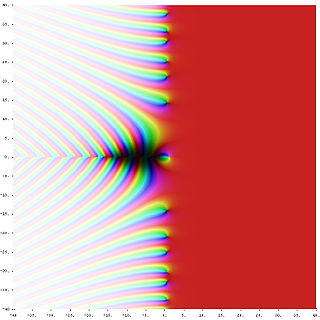Bounds on a solution and conjecture
 is roughly
is roughly  , the area inside a circle of radius
, the area inside a circle of radius  . This is because on average, each unit square contains one lattice point. Thus, the actual number of lattice points in the circle is approximately equal to its area,
. This is because on average, each unit square contains one lattice point. Thus, the actual number of lattice points in the circle is approximately equal to its area,  . So it should be expected that
. So it should be expected that

for some error term  of relatively small absolute value. Finding a correct upper bound for
of relatively small absolute value. Finding a correct upper bound for  is thus the form the problem has taken. Note that
is thus the form the problem has taken. Note that  does not have to be an integer. After
does not have to be an integer. After  one has
one has At these places
At these places  increases by
increases by  after which it decreases (at a rate of
after which it decreases (at a rate of  ) until the next time it increases.
) until the next time it increases.
Gauss managed to prove [1] that

Hardy [2] and, independently, Landau found a lower bound by showing that

using the little o-notation. It is conjectured [3] that the correct bound is

Writing  , the current bounds on
, the current bounds on  are
are

with the lower bound from Hardy and Landau in 1915, and the upper bound proved by Martin Huxley in 2000. [4]
The value of  can be given by several series. In terms of a sum involving the floor function it can be expressed as: [5]
can be given by several series. In terms of a sum involving the floor function it can be expressed as: [5]

This is a consequence of Jacobi's two-square theorem, which follows almost immediately from the Jacobi triple product. [6]
A much simpler sum appears if the sum of squares function  is defined as the number of ways of writing the number
is defined as the number of ways of writing the number  as the sum of two squares. Then [1]
as the sum of two squares. Then [1]

Most recent progress rests on the following Identity, which has been first discovered by Hardy: [7]

where  denotes the Bessel function of the first kind with order 1.
denotes the Bessel function of the first kind with order 1.
Generalizations
Although the original problem asks for integer lattice points in a circle, there is no reason not to consider other shapes, for example conics; indeed Dirichlet's divisor problem is the equivalent problem where the circle is replaced by the rectangular hyperbola. [3] Similarly one could extend the question from two dimensions to higher dimensions, and ask for integer points within a sphere or other objects. There is an extensive literature on these problems. If one ignores the geometry and merely considers the problem an algebraic one of Diophantine inequalities, then there one could increase the exponents appearing in the problem from squares to cubes, or higher.
The dot planimeter is physical device for estimating the area of shapes based on the same principle. It consists of a square grid of dots, printed on a transparent sheet; the area of a shape can be estimated as the product of the number of dots in the shape with the area of a grid square. [8]
The primitive circle problem
Another generalization is to calculate the number of coprime integer solutions  to the inequality
to the inequality

This problem is known as the primitive circle problem, as it involves searching for primitive solutions to the original circle problem. [9] It can be intuitively understood as the question of how many trees within a distance of r are visible in the Euclid's orchard, standing in the origin. If the number of such solutions is denoted  then the values of
then the values of  for
for  taking small integer values are
taking small integer values are
- 0, 4, 8, 16, 32, 48, 72, 88, 120, 152, 192 … (sequence A175341 in the OEIS ).
Using the same ideas as the usual Gauss circle problem and the fact that the probability that two integers are coprime is  , it is relatively straightforward to show that
, it is relatively straightforward to show that

As with the usual circle problem, the problematic part of the primitive circle problem is reducing the exponent in the error term. At present, the best known exponent is  if one assumes the Riemann hypothesis. [9] Without assuming the Riemann hypothesis, the best upper bound currently known is
if one assumes the Riemann hypothesis. [9] Without assuming the Riemann hypothesis, the best upper bound currently known is

for a positive constant  . [9] In particular, no bound on the error term of the form
. [9] In particular, no bound on the error term of the form  for any
for any  is currently known that does not assume the Riemann Hypothesis.
is currently known that does not assume the Riemann Hypothesis.
In mathematics, the prime number theorem (PNT) describes the asymptotic distribution of the prime numbers among the positive integers. It formalizes the intuitive idea that primes become less common as they become larger by precisely quantifying the rate at which this occurs. The theorem was proved independently by Jacques Hadamard and Charles Jean de la Vallée Poussin in 1896 using ideas introduced by Bernhard Riemann.

In mathematics, a square-free integer (or squarefree integer) is an integer which is divisible by no square number other than 1. That is, its prime factorization has exactly one factor for each prime that appears in it. For example, 10 = 2 ⋅ 5 is square-free, but 18 = 2 ⋅ 3 ⋅ 3 is not, because 18 is divisible by 9 = 32. The smallest positive square-free numbers are

In number theory, Euler's totient function counts the positive integers up to a given integer n that are relatively prime to n. It is written using the Greek letter phi as or , and may also be called Euler's phi function. In other words, it is the number of integers k in the range 1 ≤ k ≤ n for which the greatest common divisor gcd(n, k) is equal to 1. The integers k of this form are sometimes referred to as totatives of n.
The Liouville lambda function, denoted by λ(n) and named after Joseph Liouville, is an important arithmetic function. Its value is +1 if n is the product of an even number of prime numbers, and −1 if it is the product of an odd number of primes.
Additive white Gaussian noise (AWGN) is a basic noise model used in information theory to mimic the effect of many random processes that occur in nature. The modifiers denote specific characteristics:

In mathematics, analytic number theory is a branch of number theory that uses methods from mathematical analysis to solve problems about the integers. It is often said to have begun with Peter Gustav Lejeune Dirichlet's 1837 introduction of Dirichlet L-functions to give the first proof of Dirichlet's theorem on arithmetic progressions. It is well known for its results on prime numbers and additive number theory.

In mathematics, the prime-counting function is the function counting the number of prime numbers less than or equal to some real number x. It is denoted by π(x) (unrelated to the number π).

In number theory, the Mertens function is defined for all positive integers n as
In mathematics, the Poisson summation formula is an equation that relates the Fourier series coefficients of the periodic summation of a function to values of the function's continuous Fourier transform. Consequently, the periodic summation of a function is completely defined by discrete samples of the original function's Fourier transform. And conversely, the periodic summation of a function's Fourier transform is completely defined by discrete samples of the original function. The Poisson summation formula was discovered by Siméon Denis Poisson and is sometimes called Poisson resummation.
In number theory, quadratic Gauss sums are certain finite sums of roots of unity. A quadratic Gauss sum can be interpreted as a linear combination of the values of the complex exponential function with coefficients given by a quadratic character; for a general character, one obtains a more general Gauss sum. These objects are named after Carl Friedrich Gauss, who studied them extensively and applied them to quadratic, cubic, and biquadratic reciprocity laws.
In the mathematical field of complex analysis, contour integration is a method of evaluating certain integrals along paths in the complex plane.
In mathematics, a Kloosterman sum is a particular kind of exponential sum. They are named for the Dutch mathematician Hendrik Kloosterman, who introduced them in 1926 when he adapted the Hardy–Littlewood circle method to tackle a problem involving positive definite diagonal quadratic forms in four as opposed to five or more variables, which he had dealt with in his dissertation in 1924.
In number theory, the class number formula relates many important invariants of a number field to a special value of its Dedekind zeta function.

In mathematics, the Chebyshev function is either a scalarising function (Tchebycheff function) or one of two related functions. The first Chebyshev functionϑ (x) or θ (x) is given by

In number theory, the divisor summatory function is a function that is a sum over the divisor function. It frequently occurs in the study of the asymptotic behaviour of the Riemann zeta function. The various studies of the behaviour of the divisor function are sometimes called divisor problems.
In the mathematical discipline of graph theory, the expander walk sampling theorem intuitively states that sampling vertices in an expander graph by doing relatively short random walk can simulate sampling the vertices independently from a uniform distribution. The earliest version of this theorem is due to Ajtai, Komlós & Szemerédi (1987), and the more general version is typically attributed to Gillman (1998).

In mathematics, the Riemann hypothesis is the conjecture that the Riemann zeta function has its zeros only at the negative even integers and complex numbers with real part 1/2. Many consider it to be the most important unsolved problem in pure mathematics. It is of great interest in number theory because it implies results about the distribution of prime numbers. It was proposed by Bernhard Riemann (1859), after whom it is named.

Anatoly Alexeyevich Karatsuba was a Russian mathematician working in the field of analytic number theory, p-adic numbers and Dirichlet series.
In mathematics, singular integral operators of convolution type are the singular integral operators that arise on Rn and Tn through convolution by distributions; equivalently they are the singular integral operators that commute with translations. The classical examples in harmonic analysis are the harmonic conjugation operator on the circle, the Hilbert transform on the circle and the real line, the Beurling transform in the complex plane and the Riesz transforms in Euclidean space. The continuity of these operators on L2 is evident because the Fourier transform converts them into multiplication operators. Continuity on Lp spaces was first established by Marcel Riesz. The classical techniques include the use of Poisson integrals, interpolation theory and the Hardy–Littlewood maximal function. For more general operators, fundamental new techniques, introduced by Alberto Calderón and Antoni Zygmund in 1952, were developed by a number of authors to give general criteria for continuity on Lp spaces. This article explains the theory for the classical operators and sketches the subsequent general theory.
In algebra, a Landau-Mignotte bound (sometimes only referred to as Mignotte's bound) is one of a family of inequalities concerning a univariate integer polynomial f(x) and one of its factors h(x). A basic version states that the coefficients of h(x) are bounded independently of h(x) by an exponential expression involving only the degree and coefficients of f(x), i.e. only depending on f(x).















































